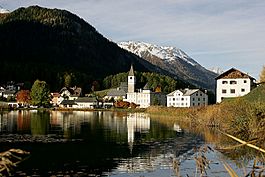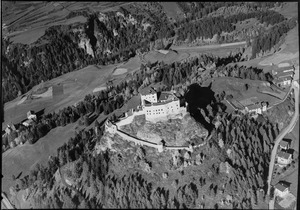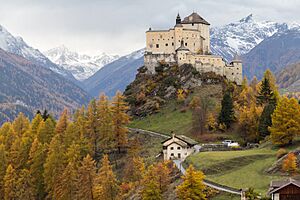Tarasp facts for kids
Quick facts for kids
Tarasp
|
||
|---|---|---|

Lake Tarasp at dawn
|
||
|
||
| Country | Switzerland | |
| Canton | Graubünden | |
| District | Inn | |
| Area | ||
| • Total | 46.9 km2 (18.1 sq mi) | |
| Elevation | 1,403 m (4,603 ft) | |
| Population
(Dec 2014)
|
||
| • Total | 337 | |
| • Density | 7.186/km2 (18.61/sq mi) | |
| Postal code |
7553
|
|
| Localities | Fontana, Vulpera, Sparsels, Aschera, Avrona, Chaposch, Chants, Florins, Nairs, Sgnè, Vallatscha | |
| Surrounded by | Ardez, Ftan, Scuol, Tschierv, Zernez | |
Tarasp was once a small town, also known as a municipality, located in the Inn area of the Swiss canton of Graubünden. It has eleven small settlements spread out in the beautiful Lower Engadin valley, right by the Inn River. These settlements are nestled at the foot of the Sesvenna Range mountains.
On January 1, 2015, Tarasp joined with other nearby towns like Ardez, Guarda, Ftan, and Sent. They all became part of a larger municipality called Scuol.
Even though the area originally spoke Romansh, most people in Tarasp today speak High Alemannic German. Tarasp is also unique because most of its people belong to the Catholic faith, which is different from the towns around it.
Contents
History of Tarasp
Early Times
People have lived in the Tarasp area for a very long time. Scientists have found old grinding stones here. These stones, sometimes called Schalensteine or Hexensteine, show that people were processing food during the Stone Age. However, we don't have clear records of settlements until the 11th century.
Tarasp Castle and Its Owners
The important area around Tarasp Castle was first established in the 11th century. For many centuries, powerful groups like the Bishopric of Chur and the Counts of Tyrol fought over who owned it.
After the original Lords of Tarasp family ended, their lands became linked to Tyrol in 1239. Later, in 1273, the Counts of Matsch managed Tarasp for the Counts of Tyrol. They continued to manage it even when the Habsburg family, who were archdukes of Austria, became the Counts of Tyrol in 1363.
From 1422 to 1436, a person named Frederick VII of Toggenburg owned Tarasp. After he died, the Matsch family took control again until 1463. Then, they sold Tarasp to the Habsburg family.
Becoming Part of Austria
When the Habsburgs bought Tarasp in 1464, it became an exclave of Austria. This meant it was a piece of Austrian land completely surrounded by the Free State of the Three Leagues. The Three Leagues were a group of states that were partners with the Old Swiss Confederacy.
In 1687, Emperor Leopold I of the Holy Roman Empire gave the Lordship of Tarasp to the Princes of Dietrichstein. This made Tarasp a special territory directly under the Emperor's rule.
Joining Switzerland
In 1803, during a big change in Europe, Austria finally gave Tarasp to the Swiss Confederation. After this, Tarasp became part of the Graubünden canton in Switzerland.
Grand Hotel Waldhaus Vulpera
A famous hotel called the Grand Hotel Waldhaus Vulpera-Tarasp opened on June 8, 1897. It was built in a fancy style called Neo-Renaissance and had special decorations called Sgraffito. This hotel was one of the most important and beautiful buildings in the Swiss Alps during the Belle Époque era in Europe.
Geography of Tarasp
As of 2006, Tarasp covered an area of about 46.9 square kilometers (18.1 square miles). Here's how the land was used:
- About 12.9% was used for farming.
- About 34.6% was covered by forests.
- Only 0.9% had buildings or roads.
- The remaining 51.6% was made up of non-productive land like rivers, glaciers, or mountains.
The former municipality is located on the right side of the Inn river. It includes the main village of Tarasp, along with 10 smaller sections and the famous castle hill.
People of Tarasp
In 2014, Tarasp had a population of 337 people. About 36.5% of the people living there in 2008 were from other countries. Over the ten years before 2008, the population grew by about 14.9%.
In 2000, the population was almost evenly split between males (49.2%) and females (50.8%). Here's a look at the age groups in 2000:
- Children (0-9 years old): 7.9%
- Teenagers (10-14 years old): 11.3%
- Older teenagers (15-19 years old): 6.7%
- Young adults (20-29 years old): 9.1%
- Adults (30-39 years old): 12.8%
- Adults (40-49 years old): 16.2%
- Adults (50-59 years old): 11.6%
- Seniors (60-69 years old): 9.1%
- Seniors (70-79 years old): 8.2%
- Seniors (80-89 years old): 6.4%
- Very old seniors (90-99 years old): 0.6%
Many adults in Tarasp have a good education. About 66.8% of people aged 25 to 64 have finished either high school or gone on to higher education, like university.
The population of Tarasp has changed over time:
| year | population |
|---|---|
| 1630 | 242 |
| 1835 | 403 |
| 1850 | 357 |
| 1900 | 278 |
| 1950 | 307 |
| 2000 | 328 |
Languages Spoken in Tarasp
In 2000, most people in Tarasp (52.4%) spoke German. The second most common language was Romansh (38.4%), and Portuguese was third (3.4%).
Even though the area was ruled by Austria for hundreds of years, people in Tarasp spoke a Romansh dialect called Vallader until World War I.
- In 1880, 92% of the people spoke Romansh.
- In 1910, it was 87%.
- By World War II (1941), the percentage dropped to 79%.
German continued to become more common. However, even in 1970, 45.3% of the population still spoke Romansh. In 1990, 58% of people could speak Romansh, even if it wasn't their first language. By 2000, 46.6% of the population could understand Romansh.
Here's a table showing the language changes:
| Languages | Census 1980 | Census 1990 | Census 2000 | |||
|---|---|---|---|---|---|---|
| Number | Percent | Number | Percent | Number | Percent | |
| German | 138 | 47.10% | 125 | 51.87% | 172 | 52.44% |
| Romansh | 129 | 44.03% | 102 | 42.32% | 126 | 38.41% |
| Italian | 8 | 2.73% | 8 | 3.32% | 8 | 2.44% |
| Population | 293 | 100% | 241 | 100% | 328 | 100% |
Important Heritage Sites
Two important places in Tarasp are recognized as heritage sites of national significance in Switzerland. These are Tarasp Castle and the Trinkhalle (which means "drinking hall").
Transportation
The Scuol-Tarasp train station is the very last stop on the eastern part of the private Rhaetian Railway network. Trains arrive here from cities like Chur and Pontresina.
See also
 In Spanish: Tarasp para niños
In Spanish: Tarasp para niños








